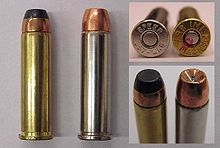| .357 Magnum | ||||||||||||||||||||
|---|---|---|---|---|---|---|---|---|---|---|---|---|---|---|---|---|---|---|---|---|
 .357 Magnum ammunition | ||||||||||||||||||||
| Type | Handgun, Carbine | |||||||||||||||||||
| Place of origin | United States | |||||||||||||||||||
| Production history | ||||||||||||||||||||
| Designer | Elmer Keith Phillip B. Sharpe Douglas B. Wesson | |||||||||||||||||||
| Designed | 1934 | |||||||||||||||||||
| Manufacturer | Smith & Wesson Winchester | |||||||||||||||||||
| Produced | 1935–present | |||||||||||||||||||
| Specifications | ||||||||||||||||||||
| Parent case | .38 Special | |||||||||||||||||||
| Case type | Rimmed, straight | |||||||||||||||||||
| Bullet diameter | .357 in (9.1 mm) | |||||||||||||||||||
| Land diameter | .346 in (8.8 mm) | |||||||||||||||||||
| Neck diameter | .379 in (9.6 mm) | |||||||||||||||||||
| Base diameter | .379 in (9.6 mm) | |||||||||||||||||||
| Rim diameter | .440 in (11.2 mm) | |||||||||||||||||||
| Rim thickness | .060 in (1.5 mm) | |||||||||||||||||||
| Case length | 1.29 in (33 mm) | |||||||||||||||||||
| Overall length | 1.59 in (40 mm) | |||||||||||||||||||
| Case capacity | 26.2 gr H2O (1.70 cm3) | |||||||||||||||||||
| Primer type | Small pistol magnum | |||||||||||||||||||
| Maximum pressure (CIP) | 44,000 psi (300 MPa) | |||||||||||||||||||
| Maximum pressure (SAAMI) | 35,000 psi (240 MPa) | |||||||||||||||||||
| Maximum CUP | 45,000 CUP | |||||||||||||||||||
| Ballistic performance | ||||||||||||||||||||
| ||||||||||||||||||||
| Test barrel length: 4 in (102 mm) (vented) Source(s): Federal,[1] | ||||||||||||||||||||
The .357 Smith & Wesson Magnum, .357 S&W Magnum, .357 Magnum, or 9×33mmR (as it is known in unofficial metric designation) is a smokeless powder cartridge with a 0.357 in (9.07 mm) bullet diameter. It was created by Elmer Keith, Phillip B. Sharpe,[2] and Douglas B. Wesson[2][3] of firearm manufacturers Smith & Wesson and Winchester.[4][5] The .357 Magnum cartridge is notable for its highly effective terminal ballistics.
The .357 Magnum cartridge is based upon Smith & Wesson's earlier .38 Special cartridge. It was introduced in 1935, and its use has since become widespread.[6]
- ^ "Federal Cartridge Co. ballistics page" Archived 2007-09-27 at the Wayback Machine. federalcartridge.com.
- ^ a b Sharpe, Phillip B. (1937). Complete Guide to Handloading. Funk & Wagnalls. pp. 405–406 – via Wayback Machine.
- ^ Wood, Keith (May 13, 2015). "10 Things You Didn't Know About Smith & Wesson". americanhunter.org. Retrieved September 20, 2019.
Daniel Wesson's grandson, Colonel Douglas B. Wesson
- ^ Metcalf, Dick (February 2000). "The 20th Century's Top Handgun Cartridges". Shooting Times. Archived from the original on 2016-03-04. Retrieved 2007-08-22.
- ^ Barnes, Frank C. (2006) [1965]. Skinner, Stan (ed.). Cartridges of the World (11th ed.). Iola, WI: Gun Digest Books. p. 299. ISBN 0-89689-297-2.
- ^ Hawks, Chuck. "The .357 Magnum". Reloading Information. Guns and Shooting Online.